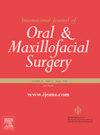重新评估腭裂瘘管管理:双对Z成形术后的纵向变化和风险决定因素。
IF 2.2
3区 医学
Q2 DENTISTRY, ORAL SURGERY & MEDICINE
International journal of oral and maxillofacial surgery
Pub Date : 2024-10-15
DOI:10.1016/j.ijom.2024.09.008
引用次数: 0
摘要
通过对1557名腭裂(CP)患者的纵向随访数据,确定了由一名外科医生实施双对位Z成形术(DOZ)后腭瘘(PF)形成的风险因素。总体而言,104 例(6.7%)患者出现了腭瘘,所有腭瘘都是在 DOZ 术后的第一个月内发现的。Veau 1、2、3 和 4 级裂隙的 PF 发生率分别为 0%、6.5%、4.4% 和 20.3%。38.5%的 PF 为针尖状,40.4%为缝隙状(2-8 毫米),21.1%为其他形状(10-96 平方毫米)。在 PF 患者中,14 例(13.5%)选择了手术修复;4 例患者复发,其中 2 例出现二次愈合。在 90 例未修复的病例中,有 68 例(75.6%)的症状得到缓解,大部分在 1-3 年内缓解。恢复情况因 PF 大小类别而异:81.1%的针尖型瘘管、71.4%的缝隙型瘘管和100%的其他瘘管分别在中位 9 个月、3 个月和 21.5 个月内自愈。多变量逻辑回归分析发现,裂隙宽度是预测 PF 发展的最重要因素(几率比 1.25,P 2),值得考虑。本文章由计算机程序翻译,如有差异,请以英文原文为准。
Re-evaluating fistula management in cleft palate: longitudinal changes and risk determinants after double-opposing Z-plasty
Longitudinal follow-up data of 1557 patients with cleft palate (CP) was used to identify risk factors for palatal fistula (PF) formation after double-opposing Z-plasty (DOZ), performed by a single surgeon. Overall, 104 (6.7%) of the patients developed PF, all of which were identified within the first month following DOZ. The incidence of PF for clefts of Veau class 1, 2, 3, and 4 was 0%, 6.5%, 4.4%, and 20.3%, respectively. The PFs were pinpoint-shaped in 38.5% of cases, slit-shaped in 40.4% (2–8 mm), and other (10–96 mm2) in 21.1% . Among patients with PF, 14 (13.5%) chose surgical repair; recurrence was observed in four patients, of whom two showed secondary healing. Among the 90 unrepaired cases, 68 (75.6%) showed symptom resolution, mostly within 1–3 years. Recovery varied by PF size category: 81.1% of pinpoint, 71.4% of slit-shaped, and 100% of other fistulas healed spontaneously over a median 9, 3, and 21.5 months, respectively. Multivariate logistic regression analysis identified cleft width as the most significant predictor of PF development (odds ratio 1.25, P < 0.001), while the Veau classification was not a significant determinant. This study identified cleft width as a critical determinant of the risk of PF following DOZ. A conservative strategy that prioritizes symptomatology over PF size (for PFs <1 cm2) is worthy of consideration.
求助全文
通过发布文献求助,成功后即可免费获取论文全文。
去求助
来源期刊
CiteScore
5.10
自引率
4.20%
发文量
318
审稿时长
78 days
期刊介绍:
The International Journal of Oral & Maxillofacial Surgery is one of the leading journals in oral and maxillofacial surgery in the world. The Journal publishes papers of the highest scientific merit and widest possible scope on work in oral and maxillofacial surgery and supporting specialties.
The Journal is divided into sections, ensuring every aspect of oral and maxillofacial surgery is covered fully through a range of invited review articles, leading clinical and research articles, technical notes, abstracts, case reports and others. The sections include:
• Congenital and craniofacial deformities
• Orthognathic Surgery/Aesthetic facial surgery
• Trauma
• TMJ disorders
• Head and neck oncology
• Reconstructive surgery
• Implantology/Dentoalveolar surgery
• Clinical Pathology
• Oral Medicine
• Research and emerging technologies.

 求助内容:
求助内容: 应助结果提醒方式:
应助结果提醒方式:


